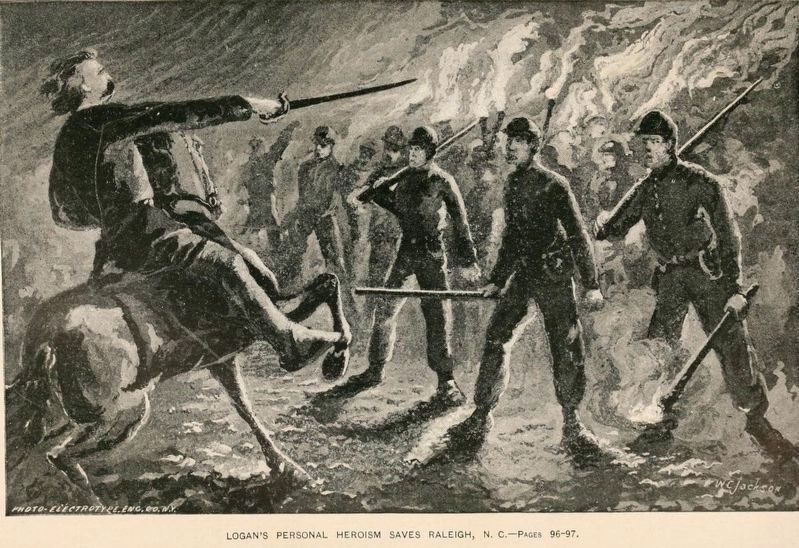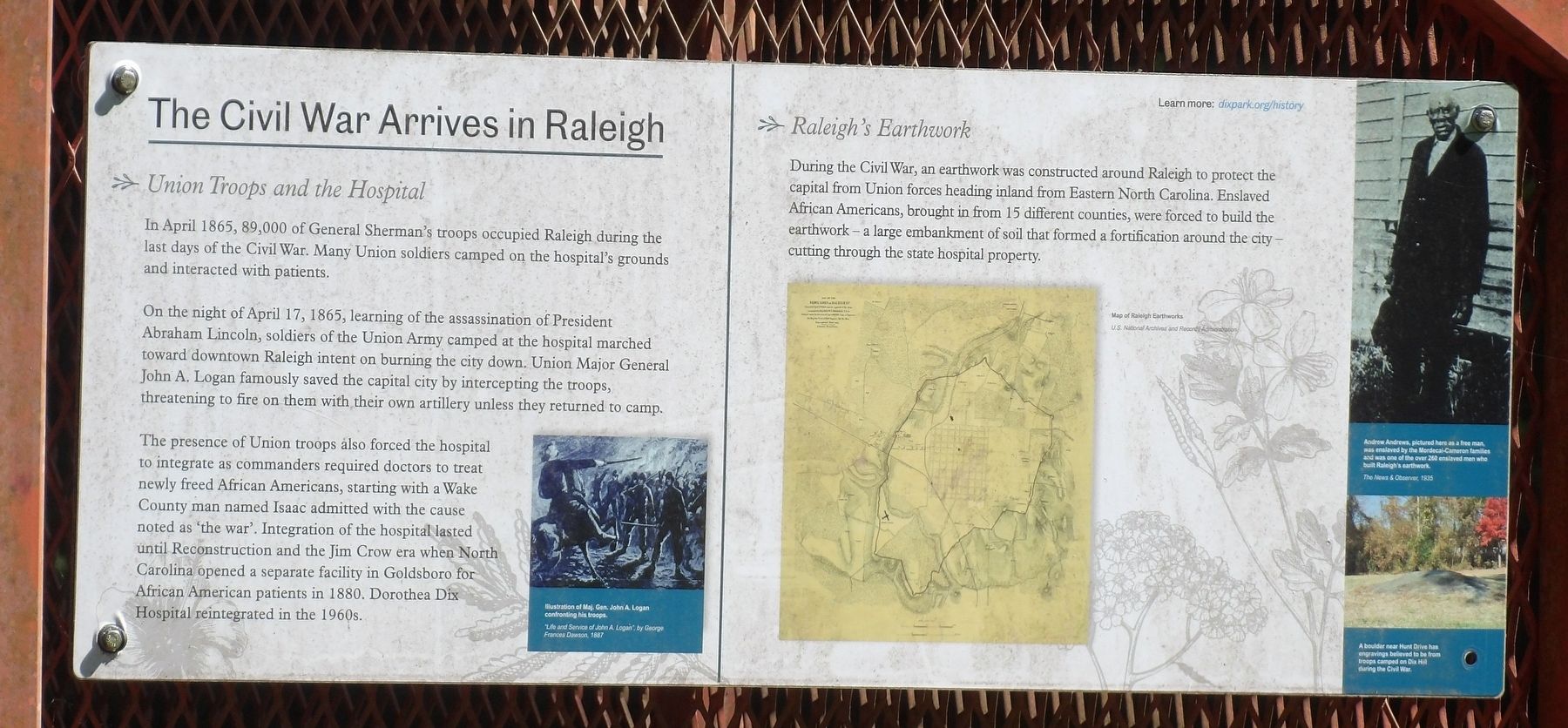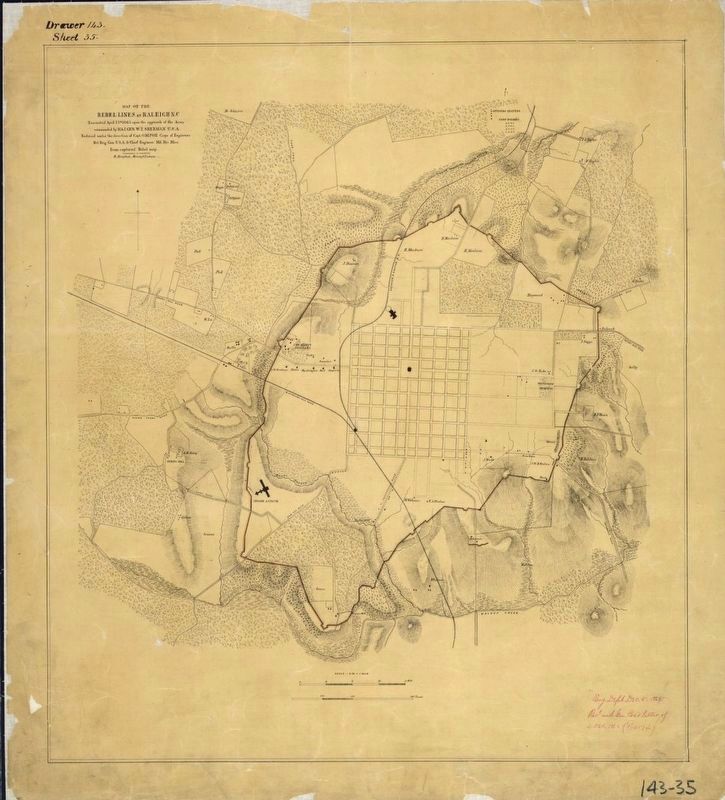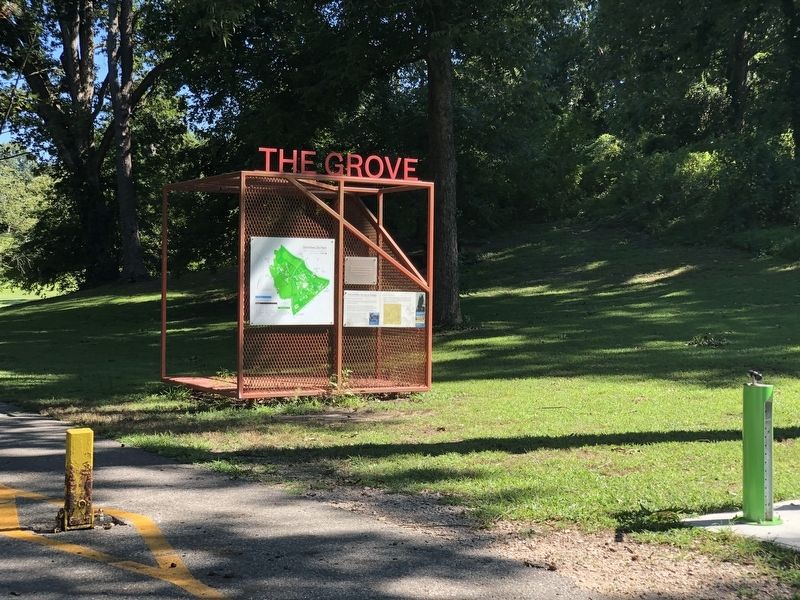Southwest Raleigh in Wake County, North Carolina — The American South (South Atlantic)
The Civil War Arrives in Raleigh
Inscription.
Union Troops and the Hospital In April 1865, 89,000 of General Sherman’s troops occupied Raleigh during the last days of the Civil War. Many Union soldiers camped on the hospital’s grounds and interacted with patients.
On the night of April 17, 1865, learning of the assassination of President Abraham Lincoln, soldiers of the Union Army camped at the hospital marched toward downtown Raleigh intent on burning the city down. Union Major General John A. Logan famously saved the capital city by intercepting the troops, threatening to fire on them with their own artillery unless they returned to camp.
The presence of Union troops also forced the hospital to integrate as commanders required doctors to treat newly freed African Americans, starting with a Wake County man named Isaac admitted with the cause noted as ‘the war’. Integration of the hospital lasted until Reconstruction and the Jim Crow era when North Carolina opened a separate facility in Goldsboro for African American patients in 1880. Dorothea Dix Hospital reintegrated in the 1960s.
Raleigh’s Earthwork During the Civil War, an earthwork was constructed around Raleigh to protect the capital from Union forces heading inland from Eastern North Carolina. Enslaved African Americans, brought in from 15 different counties, were forced to build the earthwork – a large embankment of soil that formed a fortification around the city – cutting through the state hospital property.
[Captions (clockwise from left)]
• Illustration of Maj. Gen. John A. Logan confronting his troops. “Life and Service of John A. Logan”, by George Frances Dawson, 1887.
• Map of Raleigh Earthworks. U.S. National Archives and Records Administration
• Andrew Andrews, pictured here as a free man, was enslaved by the Mordecai-Cameron families and was one of the over 260 enslaved men who built Raleigh’s earthwork. The News & Observer, 1935
• A boulder near Hunt Drive has engravings believed to be from troops camped on Dix Hill during the Civil War.
Topics. This historical marker is listed in these topic lists: African Americans • Civil Rights • Science & Medicine • War, US Civil. A significant historical date for this entry is April 17, 1865.
Location. 35° 46.25′ N, 78° 39.168′ W. Marker is in Raleigh, North Carolina, in Wake County. It is in Southwest Raleigh. Marker is on Tate Drive east of South Boylan Avenue, on the right when traveling east. Marker is on the shelter at the Rocky Branch Trailhead on the east end of Tate Drive in Dorothea Dix Park. Touch for map. Marker is at or near this postal address: 721 Tate Dr, Raleigh NC 27603, United States of America. Touch for directions.
Other nearby markers.

From Life and Services of John A. Logan, George F. Dawson (1887) via Internet Archive (Public Domain)
2. The Civil War Arrives in Raleigh Marker detail (original)
Union Maj. Gen. John A. Logan confronts and stops his troops, angry over President Lincoln's assassination, from marching on Raleigh and burning down the city on April 17, 1865.
Also see . . . The Day Raleigh (Almost) Burned Down. April of 1865 was a dangerous month for Raleigh. The end of the Civil War was at hand but armies of the North and South were slowly approaching the capital city, bringing destruction with them. (Ernest Dollar, Raleigh Magazine, April 1, 2019) (Submitted on September 24, 2023, by Duane and Tracy Marsteller of Murfreesboro, Tennessee.)
Credits. This page was last revised on September 24, 2023. It was originally submitted on September 24, 2023, by Duane and Tracy Marsteller of Murfreesboro, Tennessee. This page has been viewed 111 times since then and 49 times this year. Photos: 1, 2, 3, 4. submitted on September 24, 2023, by Duane and Tracy Marsteller of Murfreesboro, Tennessee.


